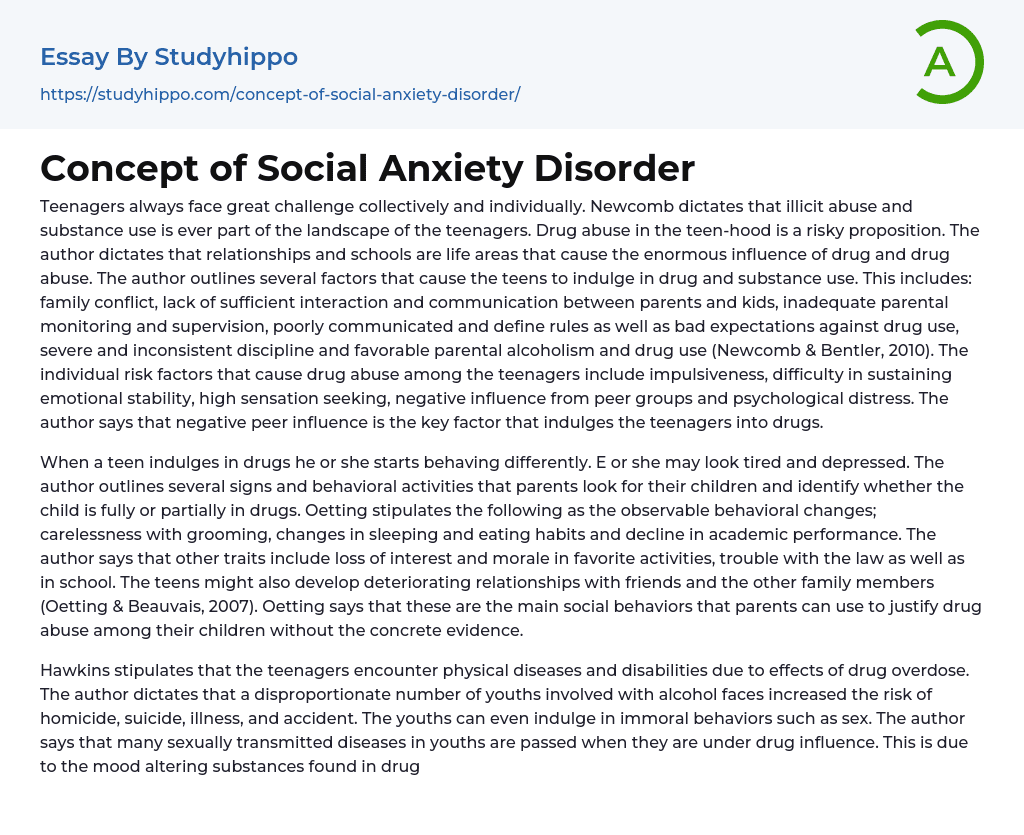Teenagers always face great challenge collectively and individually. Newcomb dictates that illicit abuse and substance use is ever part of the landscape of the teenagers. Drug abuse in the teen-hood is a risky proposition.
The author dictates that relationships and schools are life areas that cause the enormous influence of drug and drug abuse. The author outlines several factors that cause the teens to indulge in drug and substance use. This includes: family conflict, lack of sufficient interaction and communication between parents and kids, inadequate parental monitoring and supervision, poorly communicated and define rules as well as bad expectations against drug use, severe and inconsistent discipline and favorable parental alcoholism and drug use (Newcomb & Bentler, 2010). The individual risk factors that cause drug abuse among the teenagers include impulsiveness, difficulty in sustaining emotional stability,
...high sensation seeking, negative influence from peer groups and psychological distress. The author says that negative peer influence is the key factor that indulges the teenagers into drugs.
When a teen indulges in drugs he or she starts behaving differently. E or she may look tired and depressed. The author outlines several signs and behavioral activities that parents look for their children and identify whether the child is fully or partially in drugs. Oetting stipulates the following as the observable behavioral changes; carelessness with grooming, changes in sleeping and eating habits and decline in academic performance.
The author says that other traits include loss of interest and morale in favorite activities, trouble with the law as well as in school. The teens might also develop deteriorating relationships with friends and the other family members (Oetting & Beauvais, 2007). Oetting says that these ar
the main social behaviors that parents can use to justify drug abuse among their children without the concrete evidence. Hawkins stipulates that the teenagers encounter physical diseases and disabilities due to effects of drug overdose.
The author dictates that a disproportionate number of youths involved with alcohol faces increased the risk of homicide, suicide, illness, and accident. The youths can even indulge in immoral behaviors such as sex. The author says that many sexually transmitted diseases in youths are passed when they are under drug influence. This is due to the mood altering substances found in drugs. The author says that the teenagers encounter mental illness such as developmental lags, psychological dysfunctions, apathy, depressions and withdrawal among the youths.
Hawkins says that marijuana which is a common prevalent drug among the youths impair the short memory leading to a memory lapse. Hawkins says that the drug leads to impulsiveness, hallucinations, paranoia and aggressiveness. The author says that the drugs weakens the immune system and increases the body susceptibility to infections. The author outlines that the drugs cause cardiovascular conditions, from abnormal heart rate to heart attacks. Drug abuse among the teenagers causes abdominal pain, vomiting, and nausea.
Seizures and liver cirrhosis and collapsed pains are catastrophic conditions associated with drug abuse among the teenagers (Hawkins et al, 1992). The author outlines that the best way to avoid drugs is abstinence. The teenagers should say no to drug and substance use. Tobler says that teenagers should stand out boldly and say no to any negative peer influence.
The author says that if one is pressurizing you to do something negative, you have right to ask why and walk away. The
author highlights that seeking parental guidance is always health. Tobler says that we should make connections with our parents to learn from them and seek advice. Griffin and Botvin stipulate that parents should be the guiding factor for the teenagers. The parents should ensure that their children (teenagers) enjoy life in the helpful ways. The parents should teach the teenagers on effects of drug abuse and the long term health complications generated by such.
The author dictates that the parents should observe the family rules about drugs and alcohol. Through this, the author concludes that there will be a minimal number of teenagers indulged in drugs. The author asserts that the parents are the cornerstone to curb this behavior.
References
- Newcomb, M. D., & Bentler, P. M. (2010). Substance use and abuse among children and teenagers.
American psychologist, 44(2), 242
- Oetting, E. R., & Beauvais, F. (2007). Peer cluster theory, socialization characteristics, and adolescent drug use: A path analysis.
Journal of counseling psychology, 34(2), 205.
- Hawkins, J. D., Catalano, R. F., & Miller, J. Y. (1992).
Risk and protective factors for alcohol and other drug problems in adolescence and early adulthood: implications for substance abuse prevention. Psychological bulletin, 112(1), 64.
- Tobler, N. S., Roona, M. R., Ochshorn, P., Marshall, D. G., Streke, A.
V., & Stackpole, K. M. (2000). School-based adolescent drug prevention programs: 1998 meta-analysis. Journal of primary Prevention, 20(4), 275-336.
- Griffin, K. W., Botvin, G.
J., Scheier, L. M., Diaz, T., & Miller, N. L. (2000).
Parenting practices as predictors of substance use, delinquency, and aggression among urban minority youth: moderating effects of family structure and gender. Psychology of addictive behaviors, 14(2), 174.
- Emergence essays
- Anxiety Disorder essays
- Post-traumatic Stress Disorder essays
- Suicide Prevention essays
- Addiction essays
- Anatomy and Physiology essays
- Biodegradation essays
- Cancer essays
- Dental Care essays
- Disability essays
- Disease essays
- Disorders essays
- Health Care essays
- Infectious Disease essays
- Inquiry essays
- Intelligence Quotient essays
- Lung Cancer essays
- Medicine essays
- Neurology essays
- Nutrition essays
- Olfaction essays
- Physical Exercise essays
- Public Health essays
- Sex essays
- Women's Health essays
- World health organization essays
- Adhd essays
- Antisocial Personality Disorder essays
- Anxiety essays
- Bipolar Disorder essays
- Depression essays
- Depression And Anxiety essays
- Dyslexia essays
- Learning Disability essays
- Major Depressive Disorder essays
- Mental Disorder essays
- Mental Illness essays
- Psychosis essays
- Schizophrenia essays
- Stress essays
- Suicide essays
- Teenage Drinking essays
- Teenage Suicide essays




